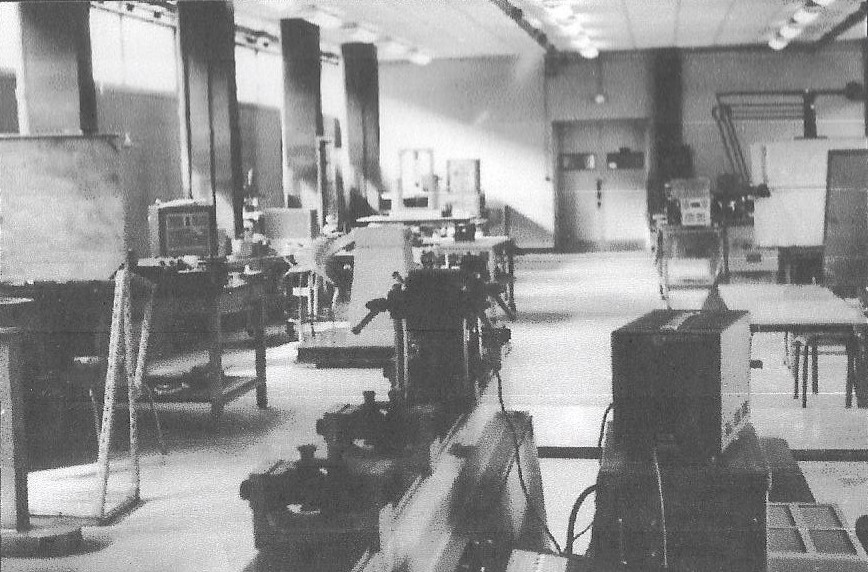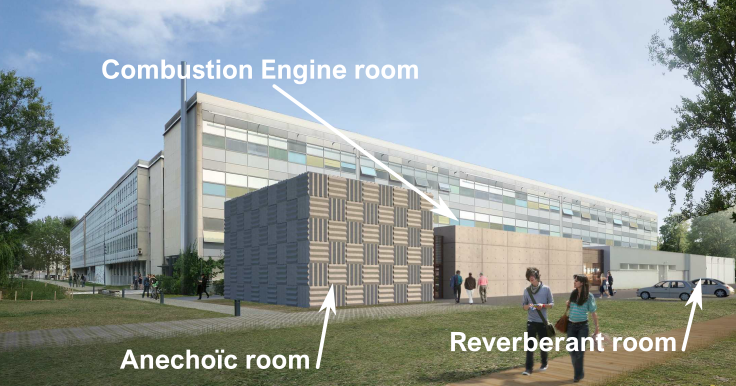The Acoustic Vibration Laboratory (LVA) at INSA Lyon: nearly sixty years of existence
News
The laboratory celebrates its 50th birthday. For the details, follow this link: https://lva50.sciencesconf.org/
For the event, here are two links to download the temporary logo: /sites/lva.insa-lyon.fr/files/logo_50_lva_horizontal.png (horizontal), /sites/lva.insa-lyon.fr/files/logo_50_lva_vertical.png (vertical)
Historical
In 1965, Claude Lesueur, then in his doctoral thesis under the supervision of Professor Francisque Salles at the National Institute of Applied Sciences (INSA) of Lyon, carried out the installation of practical vibration work on structures, such as the famous 1/5 scale staircase model and the balancer, in the premises of the current LVA. In 1972, they published together a work dedicated to structural vibrations.

Picture 1: Start of the Acoustic Vibrations Laboratory at INSA Lyon
A small team was then formed, tackling the problem of vibrations of industrial and academic structures such as beams, plates and cylindrical shells. Very quickly, Claude Lesueur directed and oriented the emerging research team towards industrial acoustics, particularly from 1974 when the laboratory became a Research entity of INSA Lyon (LVA for Laboratoire Vibrations Acoustique), thus complementing academic research in Acoustics in Lyon. Relations with industry were quite strong as well as international influence with the reception of internationally renowned researchers. In 1992, the laboratory expanded with a large hall containing a workshop and a 420 m3 reverberation room, during a first extension.
In 1990, after returning from a sabbatical year in Canada, Jean Louis Guyader became director of LVA and continued to advance the theme of acoustic radiation of structures and initiated new ones, such as acoustic perception. LVA workforce increased by welcoming four researchers in the field of Non-Destructive Control. During a second extension, the laboratory was equipped with a large semi-anechoic chamber and a quiet room intended for the noise of combustion engines and rotating machines. At the same time, Jean Louis Guyader chaired the National Council of Universities (CNU) for two terms of four years.
In 2013, a dozen years after his recruitment at INSA Lyon as Full Professor to develop the theme of acoustic perception, Etienne Parizet was elected director of LVA for two terms. The laboratory acquired a specific quiet cabin for carrying out perceptual tests. Besides, Etienne Parizet set up the Labex CeLyA (Centre Lyonnais d’Acoustique), a collaborative network of interdisciplinary teams for acoustics in Lyon. Like Jean Louis Guyader, he chaired the CNU from 2016 to 2019.
Jérôme Antoni has been elected director of LVA since 2021. The internal premises of the laboratory have been renovated as well as the practical work platforms in the basement which now meet all safety and reception standards.

Picture 2: Exterior view of the laboratory and its main current testing means, the teaching Mechanical Department (GM) behind
LVA is one of the oldest research units at INSA Lyon, perhaps the only one that has not changed its name since its creation! Proof of the relevance of this choice, consisting of being interested in both structural vibrations and acoustic radiation.
Scientific developments in LVA
Since its creation, LVA has sought to reconcile high-level academic research (which is reflected in particular by publications in all the major journals in the field) and applications in the industrial world. All of the researchers share this dual requirement: the group's average publication rate (international peer-reviewed journals) is high and all researchers are involved in contracts with industrial partners.
The purpose of the laboratory's actions consists of the study of vibro-acoustic phenomena under multiple aspects: understanding of the phenomena, modeling and forecasting, experimental characterizations, effects on humans, monitoring of machines. The reserachers contribute to several themes:
- vibro-acoustics;
- inverse methods and source identification;
- monitoring, diagnosis, non-destructive testing;
- acoustic and vibration perception.
Vibro-acoustics is the first theme born at LVA and the team has greatly participated in its development in the following areas:
- modeling vibrations and acoustic radiation of mechanical structures coupled to light or heavy fluids,
- the development of predictive models dedicated to medium frequencies,
- understanding the physical phenomena linked to the acoustic radiation of complex mechanical structures,
- the development of noise reduction solutions.
Inverse methods and source identifications are based on observing the response of the system at certain points (typically by measuring a radiated pressure field) to infer information about sources or models. Research in this theme began in the mid-1990s and focuses on the following areas:
- Source identification: inverse methods for identifying acoustic or vibration sources by measuring the resulting field. In this case, the model representing the system must be imposed or known.
- Model identification: inverse methods for determining information about the system itself through indirect measurements.
- The intrinsic characterization of sources independently of the receiving environment.
- The development and use of innovative measurement methods.
Monitoring, diagnosis, and non-destructive testing study the physical phenomena that occur within the propagation medium with the aim of characterizing the state of materials or structures, detecting defects or to monitor the in-service operation of a machine. Thanks to this collection of experimental resources, research in this domain covers all frequencies and different types of waves.
Vibration monitoring, initiated at LVA in the early 1990s, is characterized by the exploitation of vibration measurements, generally non-intrusive, and by their analysis using signal processing and machine learning. In its broad sense, vibration or acoustic monitoring includes a phase of fault detection, diagnosis (identification of the faulty element) and possibly prognosis (estimation of the residual life).
Non-Destructive Testing concerns instrumentation, modeling of physical phenomena, and data processing. The arrival of four colleagues specializing in ultrasound control and ionizing radiation imaging made it possible to enrich the activity on this field from the 2010s. The techniques concerned are ultrasound and X-rays which are “histories” of CND, but also vibration analysis which is gradually entering the field.
Acoustic or vibration perception, initiated towards the end of the 1990s, consisted of identifying the parameters of the sound or vibration signals which contribute to giving an image of product quality or comfort. This theme has found importance among industrials, particularly in transport. Testing and testing resources available in the laboratory have enabled the treatment of several subjects: acoustic discomfort in open offices, vibration comfort, vibration/acoustic coupling, optimization of fault monitoring indicators of rotating machines, the relationships between simulation and perception …
The main industrials in the sectors concerned are most of the time initiating and financing researches conducted at LVA: Airbus, SNES, Saint-Gobain, SNCF, EDF, Renault, PSA, DGA, CERDAN...etc. This can be said to be the hallmark of LVA, to have succeeded in combining industrial and research needs and to have found a style. The approaches and responses to understanding these subjects favored analytical developments in comparison to numerical methods.
Researchers at LVA also participate in the teaching of vibrations and acoustics, signal processing and mathematics within the department of mechanics of INSA Lyon, and in particular in the training of numerous doctors in acoustics, since 1980, via the Master of Science in acoustics taught jointly with the Ecole Centrale de Lyon and University of LYON I. During all these years, doctoral training and scientific production have always been very dynamic, although conducted by a small but motivated team.

